#no no no i was definitely writing it specifically circa 2002/2003
Explore tagged Tumblr posts
Text
It's 2024 and cringe is dead, have a JimmyTimmy Pacific Rim AU...... Chapter ONE of a multi-chapter JimmyTimmy PacRim AU..
Originally inspired by this art by choraa and then spurred on by @fauvester pulling me fully into nicktoons hell...
Please check out Fauve's lovely art of this AU, it is incredible.
#nicktoons#jimmytimmy#nicktoons unite#bro i just had the unsettling realization that i was writing jimmy neutron fanfiction 20 years ago#like i knew i was writing it in middle school and was like “haha i'm returning to my old fandom�� but like no...#no no no i was definitely writing it specifically circa 2002/2003#that's#there are people who can vote that were born AFTER me publishing fanfics to nick dot com web forums i...
5 notes
·
View notes
Text
A Rambling Chronicle of Marvel’s Western Comics
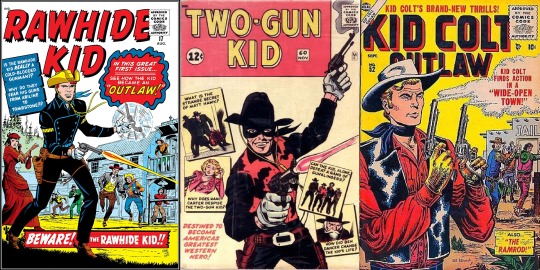
By Vincent Faust - November 27, 2018
Marvel Comics is the most prolific comic book publisher of the Western genre. Despite their near ubiquity in today’s culture with billion dollar box office receipts, even their diehard fans may not know this part of their past.
I may be missing a few scattered things, but by my count Marvel has published 1,192 issues of Western comics through their history. Marvel had published Western stories from their very beginnings with the Masked Raider in 1939′s Marvel (Mystery) Comics 1-12. Though the genre didn't explode until the late 1940s following the war, while superheroes were declining. Timely (Marvel’s name at the time) launched 7 western titles in 1948.
The "Big Three" of Marvel westerns are Kid Colt Outlaw, Rawhide Kid, and Two-Gun Kid. Each lasting an impressive 229, 151, and 136 issues respectively.
The star artist of Kid Colt was Jack Keller. Who drew most of the character's stories from 1953-1967. An impressive run. Some have argued he has the honor of drawing the most individual stories for one specific Marvel character. Many of these books had 3-5 short stories per issue, so I wouldn't argue against that. If we only count full issue stories, I'm not sure who would take that title. Probably Mark Bagley for Spider-Man, combining his lengthy 1990s run on Amazing and his history making 2000s run with Bendis on Ultimate.
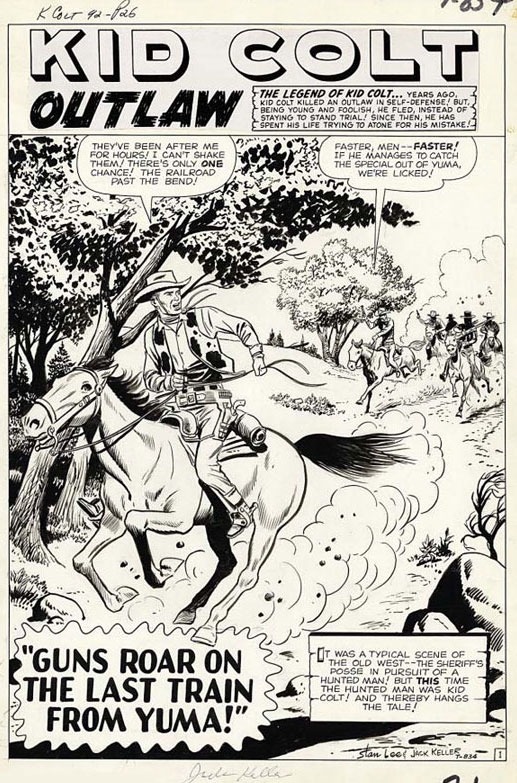
In 1960, right before the Fantastic Four, Stan Lee and Jack Kirby reinvented Rawhide Kid. After a publishing hiatus the title was brought back with issue 17. The character was now Jonathan Clay and his costume changed. Over two and a half years, their run was revered as the cream of the crop in a waning genre as their own superheroes began to explode.

As Kirby was needed more and more on the superhero titles selling like hotcakes, a tiny run by Jack Davis followed. Davis was an EC Comics legend who took a pit stop at Marvel before becoming even more of a legend at Mad Magazine. Unfortunately, practically the only classic Marvel Westerns to be reprinted in collections is this span of Rawhide Kid. With issues 17-35 reprinted across two hardcover Marvel Masterworks.

Here is Stan Lee talking to Jack Davis and fellow EC/Mad/minor Marvel contributor Harvey Kurtzman. For Marvel, the legendary Kurtzman did 150 episodes of a one-page filler strip titled Hey Look! from 1946 to 1949.
youtube
Especially as Marvel was finally able to publish more titles, Stan Lee's efforts were being stretched too thin as well. So, Rawhide Kid was handed over to his younger brother Larry Lieber to write and draw. Which he did for almost a decade, to minor acclaim from genre fans. Sounds very reminiscent of the hidden gem Gary Friedrich/Dick Ayers/John Severin run on Sgt. Fury and His Howling Commandos.
"I don't remember why I wanted to do it, particularly. I think I wanted a little more freedom. I didn't do enough of the superheroes to know whether I'd like them. What I didn't prefer was the style that was developing. It didn't appeal to me. Maybe there was just too much humor in it, or too much something. I remember, at the time, I wanted to make everything serious. I didn't want to give a light tone to it. When I did Rawhide Kid, I wanted people to cry as if they were watching High Noon or something." - Larry Lieber
Lee and Kirby also reinvented Two-Gun Kid for the early 60s, but didn't stick around as long on that one.
Other artists who made a mark on Marvel's western titles include Fred Kida, a notable Golden Age Japanese-American artist known primarily for Airboy. Also Russ Heath, who passed away only recently, and the frequent collaborators John Severin and Dick Ayers. Most of these artists were also prolific in the war genre. The genre is also to thank for the introduction of Herb Trimpe, who would go on to become the definitive Hulk artist.
The true star of the show though was one Joe Maneely. Who Stan considered his best artist before Jack Kirby returned in 1958. The Philadelphia native was skilled and fast, pumping out tons of westerns as well as the Black Knight and Yellow Claw titles, which retroactively tie his work to Marvel continuity. Unlike Kirby, Keller, and Lieber he was not particularly linked to one western title, but his most consistent would be Ringo Kid.
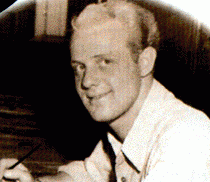
Meanwhile, outside of the genre one of Stan Lee's other top artists was Matt Baker. Considered to be the first African American professional in the field. Also there are reliable reports from friends and family that Baker may have been a gay man. He was one of the primary innovators of the "good girl" art style on Fox Feature Syndicate’s Phantom Lady and countless romance titles. Another milestone was drawing arguably the first graphic novel - It Rhymes with Lust.
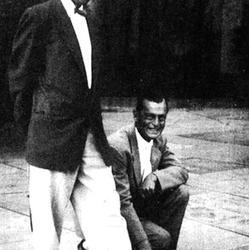
Due to some business factors in and out of publisher Martin Goodman’s control, Marvel (at this point known as Atlas Comics) nearly imploded in 1957. The bullpen was completely disbanded, leaving Stan Lee in an empty office. They went from regularly publishing almost 70 titles to only 16. Many of which were filled with inventory stories and reprints as long as Stan could manage not paying freelancers. This situation was further complicated by their new distributor having way too close of a relationship with market share leader National (now DC Comics).
Joe Maneely stepped in front of a train in 1958 at only the age of 32. It may have been a suicide. Matt Baker died of a heart attack in 1959 at 37. As stated above, Jack Kirby comes back to Marvel right around that time and Steve Ditko was quickly growing as an artist. It's tragic how close these two masters were to being on the ground floor of the Marvel Universe as we know it today. What heroes could Maneely and Baker have drawn or created?
The 1970s sees lots of reprints of classic genre comics. An exception is the original title Gunhawks (though an unrelated The Gunhawk title predated it). Though only lasting seven issues, Gunhawks has an interesting distinction. Originally starring Kid Cassidy and Reno Jones, a good ol’ plantation boy and his buddy slave. Who fought willingly for the Confederacy because some Yankees kidnapped his girlfriend. That makes sense... In the sixth issue, Cassidy is shot and killed. The finale was technically retitled to Reno Jones, Gunhawk. Making that 1973 comic book only the second at Marvel to be named after a Black protagonist, following Luke Cage. Black Panther had ongoing adventures, but had taken over the anthology title Jungle Action and wouldn’t get his own series until later. DC lagged behind Marvel in this regard.

In 1979 the western genre at Marvel was basically declared dead, with Rawhide Kid and Kid Colt finally canceled. The latter after over 30 years of continuous publication. Two Gun Kid had been canceled two years earlier. Though for a few years already, almost all of Marvel's westerns (and war books) had been turned into reprint titles.
Of those aforementioned 1,192 issues, 1,146 of them are from 1979 or earlier. Leaving less than 50 across the last 40 years.
A 1980 tryout issue with a new character (and a Frank Miller cover) goes nowhere.
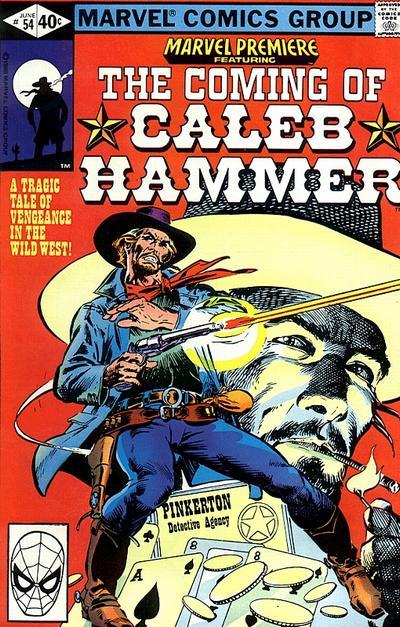
A 1985 miniseries by genre veterans Trimpe and Severin depicts the Rawhide Kid now as a middle aged man, as the West is in its final days. It is kind of depressing.

Backpedaling a bit. As the Marvel superheroes dominate, the western heroes occasionally make crazy guest appearances through the means of time travel. Most notably the Two-Gun Kid becomes an all-but-official member of the Avengers and a close friend of Hawkeye. He gets tied up with time travel generally for years to follow. Later becoming a She-Hulk supporting character and Avengers Initiative leader circa Civil War

With that cover, let's now take another aside to untangle Ghost Rider. Ghost Rider is not originally a Marvel property. The vigilante was created by Gardner Fox (Justice League of America) and Dick Ayers for Magazine Enterprises in 1949 as a horror themed western character. The feature spent time as a backup in Tim Holt and eventually broke out into its own short lived title.
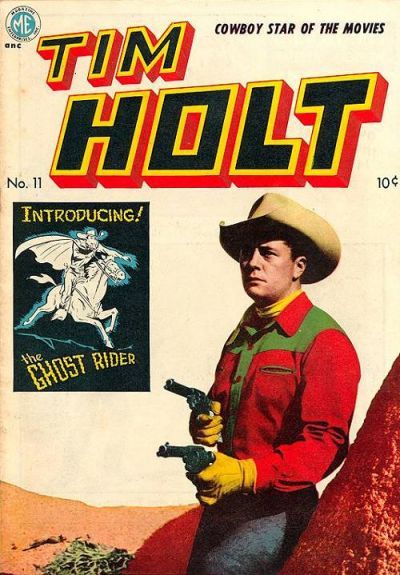
Magazine Enterprises went kapoof alongside the slump in the industry around the implementation of the Comics Code Authority in 1954. The regulation agency set up by industry leaders to avoid government intrusion following moral panic. The over-cautious guidelines severely neutered the crime and horror genres, while superheroes were already dormant, gutting many publishers. The Ghost Rider trademark expired. Marvel picked it up in 1967 for a series drawn by original creator Dick Ayers. Motivated in equal toxic parts by Martin Goodman's obsession with securing trademarks (practically every character Stan Lee created can be traced to an earlier one) and then rising writer Roy Thomas's history nerd leanings.

Obviously the name would be repurposed for the more recognizable Johnny Blaze in 1972. Marvel retroactively renamed Carter Slade as the Phantom Rider. The modern demonic versions of Ghost Rider do rarely touch on western themes. Johnny spent some time as a nomad and Garth Ennis brought in some western connections to expand the GR lore.
The western genre is basically passed over through the whole 1990s.
In 2000, John Ostrander and Leonardo Manco come around for a miniseries integrating all the Marvel western heroes together. Followed by a 2002 sequel. With revelations and deaths. The kind of lore retconning series that tickles the fancy of comic history nerds like yours truly. Ostrander also did Justice League: Incarnations around this time, tracing through the history of the JLA.

2003 comes around and it all that heavy lifting revitalization goes in the toilet. Ron Zimmerman writes a Marvel Max Rawhide Kid series. Zimmerman is some kind of comedy writer and Howard Stern regular. Well, within comics he wrote this and the god awful Ultimate Adventures - the only wholly original Ultimate Universe book, a Batman and Robin parody that was part of the U-Decide bet with Marville and PAD's Captain Marvel.
Marvel Max was a new imprint established in the early 2000s to break away from the aforementioned Comics Code and tell more daring, mature stories. Occasionally this resulted in gold like Jessica Jones. However, most of the time it was cringe inducing dreck.
So what's so bad about Rawhide Kid Max? He's now gay. Umm...OK, as long as it's handled well, maybe? Nope, constant cringey sexual innuendos which border on the protagonist coming off as a sexual predator. Some idiot gave it a sequel years later too.

Since then, we've gotten a bunch of one-shots in 2006, a weird Andy Diggle miniseries in 2012, and then the surprisingly great Marvel 1872 from Gerry Duggan during the patchwork reality crossover event Secret Wars. Which set up the Red Wolf series which was doomed by bad optics surrounding the writer and Marvel's spaghetti on the wall strategy of the time.
One of those 2006 one-shots ended up being legend Marshall Rogers's final published work. He and longtime collaborator Steve Englehart did it while waiting for DC to greenlight Dark Detective III, the second spiritual sequel to their influential 1970s run on Batman.

Here’s hoping we get to see some of these legendary heroes on the trail once more. At the very least we will get another tiny snippet in 2019 with a Gunhawks one-shot being brought back in celebration of Marvel’s 80th anniversary. Written by crime comics duo David and Maria Lapham.
This concludes a rambling chronicle of Marvel's history with the western genre and considerable tangents touching more generally on the history of Marvel and the comic book industry.
5 notes
·
View notes